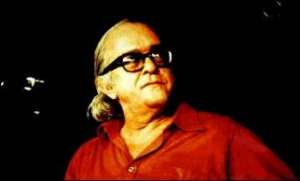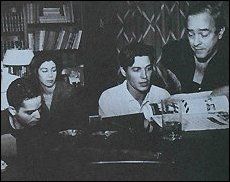The Bossa Nova Years
(Text from Marc Berthon)
![]()
You are listening to The Girl from Ipanema from Antônio Carlos Jobim and Vinícius de Moraes.
Beautiful. A dream body. This
afternoon, the girl in bikini who is walking on Ipanema beach, sensual and distant, is just simply sublime. Divine
spectacle in front of which the three friends of the beach, Tom, Vinícius and João, the tenderised eye and the fuzzy spirit (sun, idleness and beer have had enough time,
since twelve, to carry out their work quietly), remain as nailed to their cane armchairs, their senses as dynamited.
Strong emotion, so strong song. Antônio
Carlos Jobim (Tom) signs the partition,
Vinícius de Moraes, poet and diplomat, signs the words:
Recorded in 1962, sung by the
guitarist João Gilberto, from Bahia,
The Girl from Ipanema, with twenty-five million copies sold to date, is the second
song the most played in the world, after " Yesterdays "by the Beattles. It is too the perfect illustration
of the " Bossa Nova " spirit, the most sophisticated musical movement born on the Brazil ground.
The Bossa nova, " new beat
" in English, is first of all both a poetic, lyric, simple and complex atmosphere. It is a soft rhythm, with
fluid and pure melodies. It is still a sound, related to a very particular place, the town of Rio de
Janeiro, Copacabana, Ipanema, Corcovado... A sound which makes you floating. It is associated with a whole life " tropicalist
" philosophy, with a speech which exalts love, women, Muses, ocean, pleasure. Bewitching, intimists and exquisitely
carnal songs which take you along to the sea and invite you to idleness.

Tall and tan and young and lovely
The girl from Ipanema goes walking
And when she passes, each one she passes goes
When she walks she's like a samba that
Swings so cool and sways so gentle,
That when she passes, each one she passes goes



|
A history, Bossa Nova, which begins at the end of the 50's, in Rio within one of the few euphoric moments that Brazil could have know: democratic freedom, economic development, arts and football prosper in the biggest South American country. Carrying environment creates easy life. |
|
|
|
The initiator of the movement is Antônio Carlos Jobim, prolific and talented composer, tall man with a courteous, ironic and nonchalant look. With a classical formation, Jobim, who asserts as much the " serious " influence of a Villa-Lobos as the " popular " of Ary Barroso (composer of the famous Brazil, or Aquarela do Brasil, sung by Élis Regina among others), defines Bossa Nova as " the meeting of the Samba and the modern Jazz ". A flexible and regular beat, straight extracted from the general polyrythmy of the Samba, a sober, delicate and natural dial tone, the whole combined with a great harmonic and melancholic richness, and there you have it ! |
|
Beginning of the hostilities in 1959. With two key events. First of all, the release of the manifesto disc by João Gilberto and Tom Jobim, Chega de Saudade |
|
|
|
In
1962, the Bossa wave breaks on the United
States.
Frank
Sinatra,
Ella Fitzgerald,
Sarah
Vaughan,
Dizzy
Gillespie,
Paul
Desmond, Gerry
Mulligan,
Quincy
Jones,
Paul Winter,
and even Miles
Davis
or Sonny Rollins,
everyone succumbs to the irresistible charms of the carioca melodies.
And while Gilberto,
Jobim, Bonfá
or Baden Powell,
the last of the band, are setting up for a moment in New
York, the saxophonist Stan
Getz
enters heart and soul in the movement. So he devoted two whole years
of his life, he enrolled the singer Astrud Gilberto,
João's
wife, and he recorded with the greatest Bossa novists the value of five
now legendary albums. As many songs, as many potential hits : Desafinado |
|
From
the middle of the 60's, the main thing is settled. Bossa has became
a universal, integrated genre and recovered by all the other currents
of modern music, Jazz, Variety, Pop and Rock. If Gilberto
and Jobim
seldom leave the American continent, Baden
Powell,
continually travels all over the world. Idem for Vinícius
de Moraes
who, all over the 70's
and till his death, in 1980, receives with Toquinho,
guitarist and singer, the most effective help. In Brazil, the next generations will reveal
different other great creators, other musical currents. But everyone,
whatever they are, will assert high and strong the heritage of Bossa
Nova, national heritage before being world-wide. Artists such as Jorge
Ben,
Élis Regina,
Gal
Costa, Caetano
Veloso,
Trio
Esperança...,
would certainly not be what they are today if they had not taken pleasure
with humming, one day or another, the subtle and merry refrains of Desafinado |
|